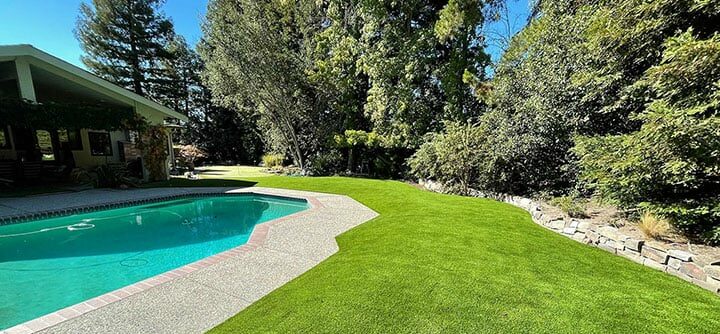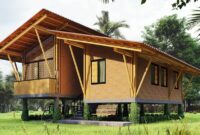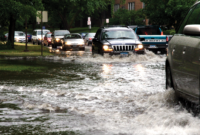Installing Artificial Grass on Concrete – Artificial grass is an excellent solution for transforming dull concrete spaces into lush, green areas that require minimal maintenance.
Whether you’re looking to enhance a patio, rooftop, or balcony, installing synthetic turf can give you a natural, beautiful look without the hassle of real grass.
In this guide, we’ll walk you through the entire process of installing artificial grass on concrete.
Why Install Artificial Grass on Concrete?
Concrete surfaces may be practical, but they lack the warmth and beauty of natural landscapes. Artificial grass offers several benefits:
- Low maintenance: No need for watering, mowing, or fertilizing.
- Durability: With proper care, synthetic grass can last for years.
- Aesthetic appeal: Adds greenery and softness to otherwise hard surfaces.
- Versatility: Perfect for patios, balconies, rooftops, and driveways.
- Cost-effective: Eliminates the need for lawn upkeep and saves water.
Read also:
1. Step-by-Step Guide: How to Install Artificial Grass Like a Pro
2. Revitalize Synthetic Lawn: How to Clean Artificial Grass Effectively
3. 47 Creative Artificial Grass Ideas to Elevate Your Front Yard
Materials and Tools You’ll Need
Before you begin, gather the necessary materials and tools:
- Artificial grass rolls (suitable for outdoor use)
- Weed membrane or geotextile fabric (for drainage and weed prevention)
- Adhesive or double-sided tape (for securing the grass)
- Shock-absorbing underlay (optional, for extra comfort)
- Outdoor silicone sealant (optional, for edges and seams)
- Utility knife (for cutting the grass)
- Trowel (for applying adhesive)
- Broom or stiff brush (for grooming the grass fibers)
Step 1: Prepare the Concrete Surface
Preparation is key to a successful artificial grass installation. Here’s how to prep your concrete:
- Clean the surface: Start by sweeping away any debris, dirt, or leaves from the concrete. A clean surface helps the adhesive bond better.
- Check for damage: Inspect the concrete for any cracks, holes, or uneven areas. Repair any imperfections with concrete filler to ensure a smooth surface.
- Ensure proper drainage: If your concrete surface has poor drainage, water can pool under the artificial grass, leading to mold or mildew. You can create small drainage holes in the concrete or ensure that the area slopes slightly to allow water runoff.
Step 2: Install Shock-Absorbing Underlay (Optional)
If you want a softer surface, especially for areas where children play or where you’ll be walking barefoot, consider adding a shock-absorbing underlay. This layer adds extra cushioning and helps with drainage. Here’s how to install it:
- Measure and cut the underlay: Lay the underlay across the concrete and cut it to size using a utility knife. Make sure it fits neatly around edges and corners.
- Secure the underlay: Use adhesive or double-sided tape to attach the underlay to the concrete. Apply the adhesive evenly to avoid lumps.
Step 3: Lay the Weed Membrane
While weed growth on concrete is unlikely, a weed membrane helps with drainage and prevents any weeds from growing up through cracks in the concrete. It also acts as a stable base for the artificial grass.
- Lay out the membrane: Roll the weed membrane across the area where you’ll be installing the turf.
- Cut and secure the membrane: Trim the membrane to fit the space, ensuring it covers the entire surface. You can use outdoor adhesive or double-sided tape to hold the membrane in place.
Step 4: Lay the Artificial Grass
Now it’s time to lay your artificial grass:
- Position the grass rolls: Unroll the artificial grass over the concrete, ensuring the grass fibers are all facing the same direction for a uniform look. Leave a bit of overhang around the edges for trimming later.
- Trim to fit: Use a utility knife to trim the grass around the edges. Be careful to make precise cuts, especially around corners or curves, to ensure a clean fit.
- Join seams (if necessary): If you’re using multiple rolls of grass, line up the seams carefully. Apply outdoor silicone sealant or special seam tape underneath the seam to hold the edges together.
Step 5: Secure the Grass
Once your artificial grass is laid out and trimmed, it’s time to secure it to the concrete.
- Apply adhesive or tape: Depending on your preference, you can use outdoor adhesive or double-sided tape to fix the grass to the concrete. Apply adhesive around the perimeter and at key points in the middle to prevent movement.
- Press the grass down: Firmly press the grass into the adhesive to ensure a strong bond. Make sure to apply pressure evenly to avoid bubbles or lumps.
- Secure edges: For added durability, apply silicone sealant around the edges to prevent the grass from lifting over time.
Step 6: Groom the Grass
Once the artificial grass is fully installed and secured, take some time to groom it:
- Brush the fibers: Use a stiff broom or brush to lift the grass fibers. This will help make the turf look more natural and lush.
- Add infill (optional): Depending on the type of artificial grass you’ve chosen, you might need to add a layer of infill, such as silica sand or rubber granules. This step helps support the grass fibers and improves drainage.
Step 7: Regular Maintenance
While artificial grass requires minimal maintenance, you should still follow these steps to keep it looking its best:
- Clean debris regularly: Sweep away leaves, dirt, and other debris to prevent buildup.
- Hose it down occasionally: Rinse the grass with water to keep it fresh and clean, especially in dusty or high-traffic areas.
- Brush the grass fibers: Periodically brush the turf to keep the fibers upright and looking natural.
Read more: Artificial Grass Installation Costs: Factors, Pricing, and Budgeting Tips
Final Thoughts
Installing artificial grass on concrete is a fantastic way to refresh your outdoor space, making it more welcoming and aesthetically pleasing.
With just a few materials and some basic tools, you can complete the installation yourself in a matter of hours. Follow this step-by-step guide, and you’ll be enjoying a green, low-maintenance surface that lasts for years.
Now that you know how easy it is to install artificial grass on concrete, get started on your own project and transform your space today!







